PatioDaddio
Babbling Farker
- Joined
- May 4, 2008
- Location
- Boise...
Pressure Cooker Stock
Stock is an essential ingredient and secret to great cooking. A good stock
is necessary to make soups, sauces, gravies (among my other things) that
really shine. Sure, you can grab a box or can of “stock” or broth from your
local grocer, but it seriously pales in comparison to the real thing. Not to
mention that they are almost always loaded with sodium.
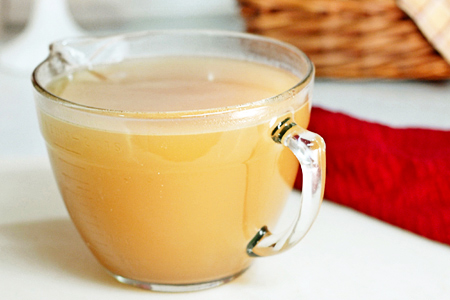
It used to be that when I heard or read the word “stock” I would think,
“Oh, come on! Who has that kind of free time? I can’t stand around all day
tending a stockpot. I have a life, people!” It’s true that making stock the
traditional old-school way takes many hours. Yes, the results are worth it,
but that doesn’t change the fact that most normal folk don’t have that
kind of time.
I recently stumbled upon a method of making stock that reduces the stock
cooking time to a mere hour. At first I thought that this would be akin to
making a great prime rib in a microwave. Then, once I researched and
pondered it further I realized that it actually produces a better product.
How’s that? I’m glad you asked.
Stock is literally all about creating a flavorful liquid by wringing flavor and
nutrients from the ingredients. This usually entails simmering bones,
veggies, herbs, and seasonings in water for several hours. You have to
simmer it long and slow in order to allow all of the good stuff to be
released. You should avoid boiling a stock because the violent bubbling
breaks down the ingredients and produces an overly cloudy product.
Enter the pressure cooker. The magic of a pressure cooker is that the
sealed environs allow the boiling point of water to be raised significantly
above the usual 212 degrees. This causes foods to cook much quicker
while retaining more of their nutrients. Additionally, because the water
never boils, there is no violent bubbling. Think of it as turbo-boiling in still
water. It’s a beautiful thing.
Here, let me show you how this works.
Caution: Pressure cookers can be dangerous, so please make sure you
read and heed the manufacturer’s instructions and warnings.
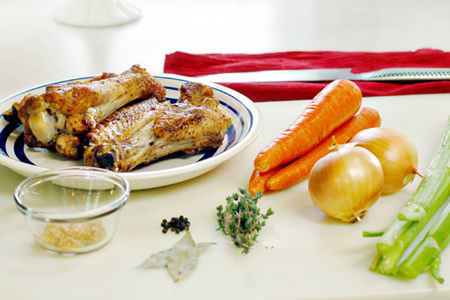
First, we need to roast the turkey parts. Sure, you can use a carcass of a
previously-roasted bird, buy I find this to be far easier, better, and more
consistent. I use one package of wings (about three pounds).
Preheat your oven to 350 degrees.
Using a cleaver or large knife, carefully cut each wing at each joint. I
discard the tips.
Season the wing pieces with kosher salt and pepper.
Roast the turkey parts on a sheet pan for 90 minutes, then remove them
from the oven and let cool to room temperature, or refrigerate for up to
three days.
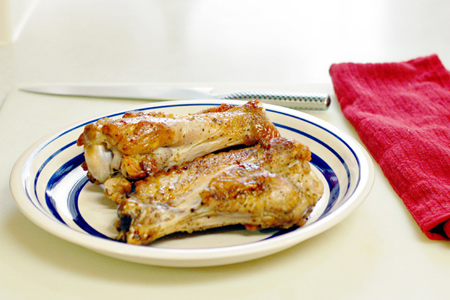
Clean the carrots (there’s no need to peel them), celery, and peel the
onions.
Rough chop all of the vegetables. The size doesn’t really matter, just chop
them up.
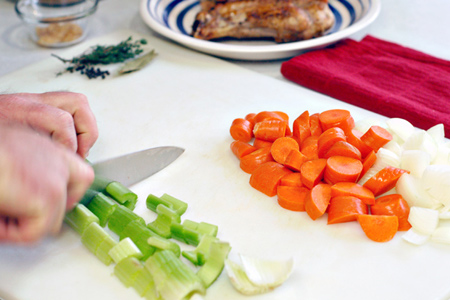
Dump everything in your pressure cooker.
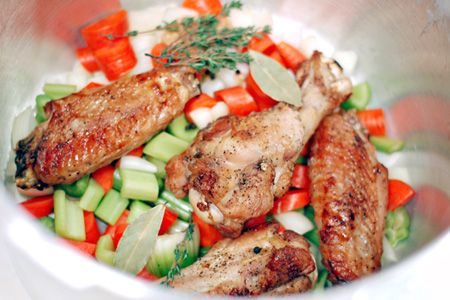
Add the water.
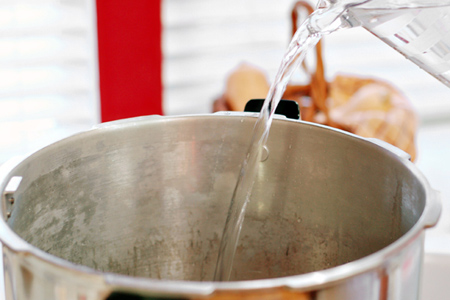
You want to just barely cover the ingredients, so add more or less water
as needed.
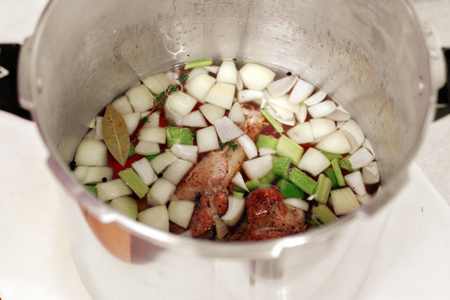
Seal your pressure cooker per the directions, and bring to 15 pounds of
pressure.
Reduce the heat as needed to maintain a pressure of 15 pounds and cook
for 45 minutes.
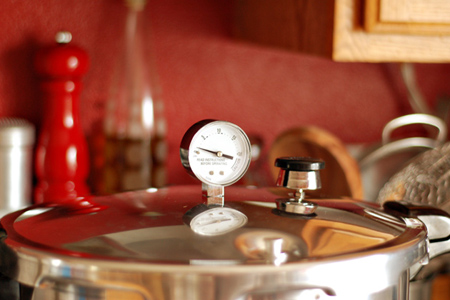
Remove the cooker from the heat and let it cool until the pressure is
completely relieved.
Open the cooker and remove the large pieces of meat, bone and
vegetables with a large slotted spoon.
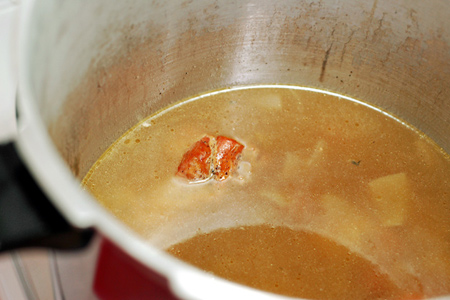
You can see what a great job the pressure cooker does. The meat
completely falls off the bone with almost no effort. Our dog really
appreciates this part (the leftover meat, not the bones).

Filter the stock through a very fine strainer and cool immediately. If you
want a clearer stock, filter it through a colander that is lined with a clean
kitchen towel. I used this batch to make gravy, so I didn’t care about it
being a little cloudy. Now that I think about it, I rarely care.
Once the stock is cold, you can easily remove the solidified fat from the
top.
Store in the refrigerator for up to four days, or freeze for long-term
storage.
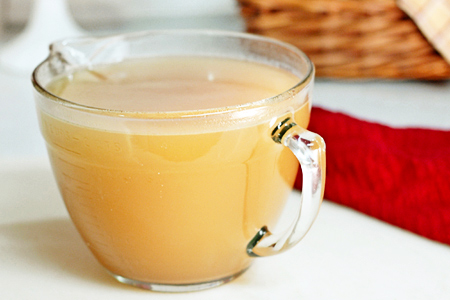
Use as needed.
Enjoy!
Notes
John
Stock is an essential ingredient and secret to great cooking. A good stock
is necessary to make soups, sauces, gravies (among my other things) that
really shine. Sure, you can grab a box or can of “stock” or broth from your
local grocer, but it seriously pales in comparison to the real thing. Not to
mention that they are almost always loaded with sodium.

It used to be that when I heard or read the word “stock” I would think,
“Oh, come on! Who has that kind of free time? I can’t stand around all day
tending a stockpot. I have a life, people!” It’s true that making stock the
traditional old-school way takes many hours. Yes, the results are worth it,
but that doesn’t change the fact that most normal folk don’t have that
kind of time.
I recently stumbled upon a method of making stock that reduces the stock
cooking time to a mere hour. At first I thought that this would be akin to
making a great prime rib in a microwave. Then, once I researched and
pondered it further I realized that it actually produces a better product.
How’s that? I’m glad you asked.
Stock is literally all about creating a flavorful liquid by wringing flavor and
nutrients from the ingredients. This usually entails simmering bones,
veggies, herbs, and seasonings in water for several hours. You have to
simmer it long and slow in order to allow all of the good stuff to be
released. You should avoid boiling a stock because the violent bubbling
breaks down the ingredients and produces an overly cloudy product.
Enter the pressure cooker. The magic of a pressure cooker is that the
sealed environs allow the boiling point of water to be raised significantly
above the usual 212 degrees. This causes foods to cook much quicker
while retaining more of their nutrients. Additionally, because the water
never boils, there is no violent bubbling. Think of it as turbo-boiling in still
water. It’s a beautiful thing.
Here, let me show you how this works.
Caution: Pressure cookers can be dangerous, so please make sure you
read and heed the manufacturer’s instructions and warnings.

First, we need to roast the turkey parts. Sure, you can use a carcass of a
previously-roasted bird, buy I find this to be far easier, better, and more
consistent. I use one package of wings (about three pounds).
Preheat your oven to 350 degrees.
Using a cleaver or large knife, carefully cut each wing at each joint. I
discard the tips.
Season the wing pieces with kosher salt and pepper.
Roast the turkey parts on a sheet pan for 90 minutes, then remove them
from the oven and let cool to room temperature, or refrigerate for up to
three days.

Clean the carrots (there’s no need to peel them), celery, and peel the
onions.
Rough chop all of the vegetables. The size doesn’t really matter, just chop
them up.

Dump everything in your pressure cooker.

Add the water.

You want to just barely cover the ingredients, so add more or less water
as needed.

Seal your pressure cooker per the directions, and bring to 15 pounds of
pressure.
Reduce the heat as needed to maintain a pressure of 15 pounds and cook
for 45 minutes.

Remove the cooker from the heat and let it cool until the pressure is
completely relieved.
Open the cooker and remove the large pieces of meat, bone and
vegetables with a large slotted spoon.

You can see what a great job the pressure cooker does. The meat
completely falls off the bone with almost no effort. Our dog really
appreciates this part (the leftover meat, not the bones).

Filter the stock through a very fine strainer and cool immediately. If you
want a clearer stock, filter it through a colander that is lined with a clean
kitchen towel. I used this batch to make gravy, so I didn’t care about it
being a little cloudy. Now that I think about it, I rarely care.
Once the stock is cold, you can easily remove the solidified fat from the
top.
Store in the refrigerator for up to four days, or freeze for long-term
storage.

Use as needed.
Enjoy!
Notes
- You can use this recipe to make other types of stock, like chicken or
beef. Just use those meats and bones in lieu of the turkey. For
example, you can use a cut-up roasted deli chicken to make chicken
stock, or use cut-up beef back ribs (roasted just like the turkey) to
make beef stock. When making beef stock I would add 2 tablespoons
of tomato paste for added richness. - If you don’t have a pressure cooker, just use a large covered stock
pot. Bring it just barely to a boil, then move the covered pot to a
180-degree oven for six hours. There is no need to stir or tend it at
all.
John
